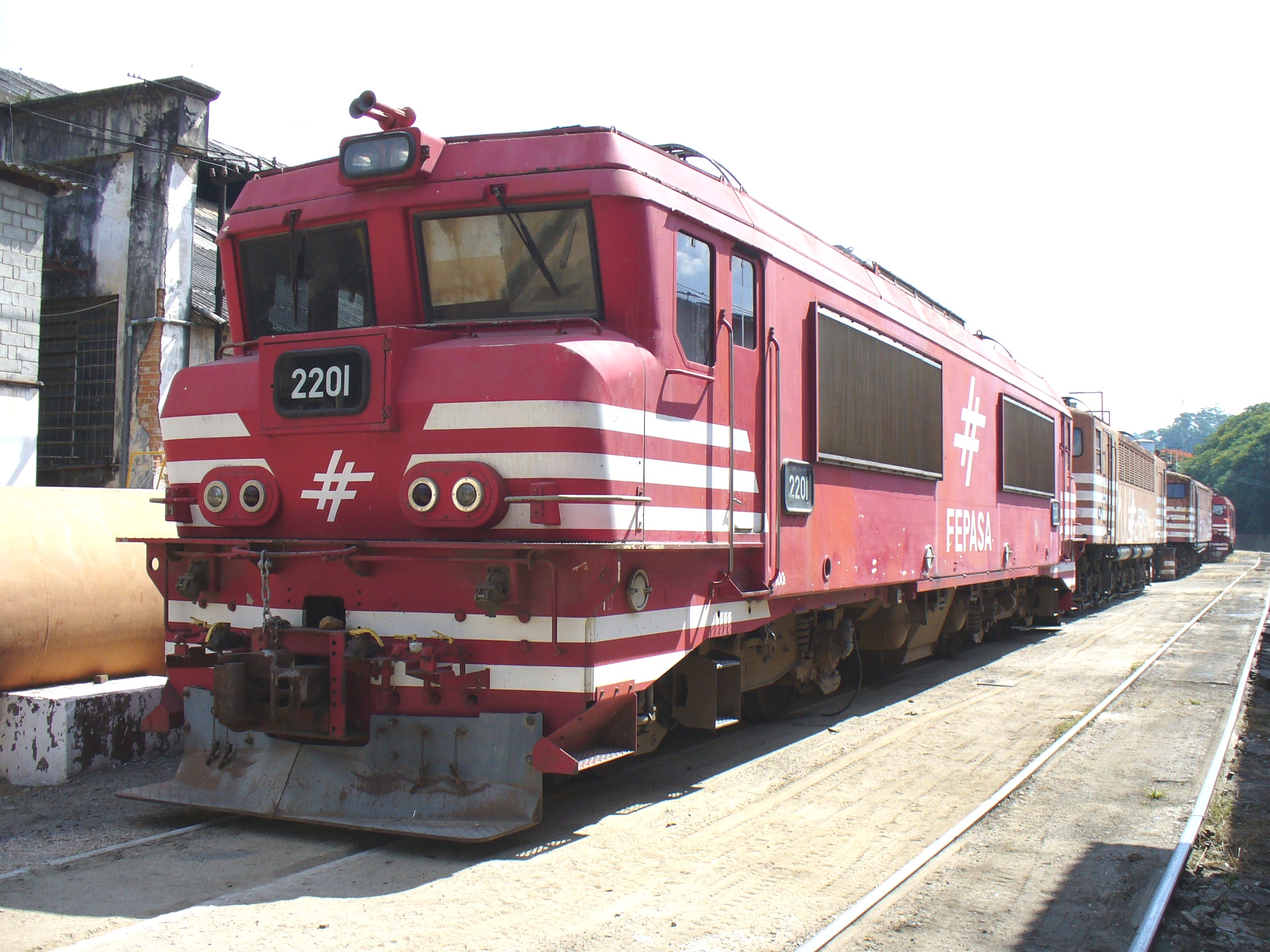|
Júlio Prestes (CPTM)
Júlio Prestes is a train station on ViaMobilidade Line 8-Diamond, located in the district of Santa Cecília in São Paulo. This historical station was named after former Governor of São Paulo and former President-elect of Brazil, Júlio Prestes. Currently, the station serves only Line 8-Diamond. The station is the head office of the State Secretariat of Culture of São Paulo and, since 1999, the concert house for the São Paulo Symphonic Orchestra (Osesp), Sala São Paulo. In Praça Júlio Prestes, it is possible to see the bronze statue of Alfredo Maia and the iron abstract structure of Emanoel Araújo. History The original stations was opened on 10 July 1872 by Estrada de Ferro Sorocabana, which was one of the most important railways in Brazil, and it was named São Paulo Station. Its function was to transport coffee bean bags from southwest and western São Paulo and northern Paraná to the capital. The old station was aside from Luz Station, what facilitated the coffee t ... [...More Info...] [...Related Items...] OR: [Wikipedia] [Google] [Baidu] |
Santa Cecília (district Of São Paulo)
Santa Cecília is a district in the city of São Paulo, Brazil. Santa Cecilia is a district in central region of São Paulo city. It covers the neighbourhoods of Campos Elíseos (São Paulo), Campos Elísios, Santa Cecília, Várzea da Barra Funda (Lower Barra Funda). Some of the important places and attractions of Santa Cecilia include: Santa Cecilia Subway Station, Maceió Square, Princess Isabel and Julio Prestes Parks/Plazas. Santa Cecilia was once a wealthy area of São Paulo, but now has many decaying buildings and areas, but recently has seen an increase in development. It contains a major shopping centre. Santa Cecilia is served by Line 3 (Red) Metro de São Paulo, stations Barra Funda, Maceió and Santa Cecilia. It is also served by Line 8 of CPTM, Estação Júlio Prestes, Júlio Prestes Station. Districts of São Paulo {{MesoregionSãoPaulo-geo-stub ... [...More Info...] [...Related Items...] OR: [Wikipedia] [Google] [Baidu] |
Great Depression
The Great Depression was a severe global economic downturn from 1929 to 1939. The period was characterized by high rates of unemployment and poverty, drastic reductions in industrial production and international trade, and widespread bank and business failures around the world. The economic contagion began in 1929 in the United States, the largest economy in the world, with the devastating Wall Street stock market crash of October 1929 often considered the beginning of the Depression. Among the countries with the most unemployed were the U.S., the United Kingdom, and Weimar Republic, Germany. The Depression was preceded by a period of industrial growth and social development known as the "Roaring Twenties". Much of the profit generated by the boom was invested in speculation, such as on the stock market, contributing to growing Wealth inequality in the United States, wealth inequality. Banks were subject to laissez-faire, minimal regulation, resulting in loose lending and wides ... [...More Info...] [...Related Items...] OR: [Wikipedia] [Google] [Baidu] |
Music Venues In São Paulo
Music is the arrangement of sound to create some combination of form, harmony, melody, rhythm, or otherwise expressive content. Music is generally agreed to be a cultural universal that is present in all human societies. Definitions of music vary widely in substance and approach. While scholars agree that music is defined by a small number of specific elements, there is no consensus as to what these necessary elements are. Music is often characterized as a highly versatile medium for expressing human creativity. Diverse activities are involved in the creation of music, and are often divided into categories of composition, improvisation, and performance. Music may be performed using a wide variety of musical instruments, including the human voice. It can also be composed, sequenced, or otherwise produced to be indirectly played mechanically or electronically, such as via a music box, barrel organ, or digital audio workstation software on a computer. Music often plays a key r ... [...More Info...] [...Related Items...] OR: [Wikipedia] [Google] [Baidu] |
Museum Of The Portuguese Language
The Museum of the Portuguese Language (, ) is an interactive Portuguese language—and Linguistics/Language Development in general—museum in São Paulo, Brazil. It is housed in the Luz Station, Estação da Luz railway station, in the urban district of the same name. Three hundred thousand passengers arrive and leave the station every day, and the choice of the building for the launching of the museum is connected to the fact that it was mainly here that thousands of non-Portuguese speaking Immigration to Brazil, immigrants arriving from Europe and Asia into São Paulo via the Port of Santos got acquainted with the language for the first time. The idea of a museum-monument to the language was conceived by the São Paulo Secretary of Culture in conjunction with the Roberto Marinho Foundation, at a cost of around 37 million Brazilian real, reais. The objective of the museum is to create a living representation of the Portuguese language, where visitors may be surprised and educated ... [...More Info...] [...Related Items...] OR: [Wikipedia] [Google] [Baidu] |
Pinacoteca Do Estado De São Paulo
The Pinacoteca de São Paulo (Portuguese for "pinacotheca (picture gallery) of the state of São Paulo") is a visual arts museum focused on Brazilian art from the 19th century to the present day, in dialogue with various cultures from around the world. Founded in 1905 by the Government of the State of São Paulo, the Pinacoteca is the oldest art museum in the city and has three buildings: Pinacoteca Luz, Pinacoteca Estação and Pinacoteca Contemporânea. The museum holds exhibitions of its renowned collection of Brazilian art and temporary exhibitions of national and international artists. The Pinacoteca also develops and presents multidisciplinary public projects, in addition to hosting a comprehensive and inclusive educational program. The original collection was formed from the transfer of 20 works from the Museu Paulista of the University of São Paulo, together with another 6 works acquired from important artists from the city such as Almeida Júnior, Pedro Alexandrino, ... [...More Info...] [...Related Items...] OR: [Wikipedia] [Google] [Baidu] |
Ferrovia Paulista S/A
Ferrovia Paulista S/A (FEPASA) was a São Paulo (state), São Paulo State ownership, state-owned freight and passenger Rail transport company, railway company, created by merging Companhia Paulista de Estradas de Ferro, Paulista Railroads Company (CPEF), Mogiana Railroads Company (CMEF), Sorocabana Railroad (EFS), Araraquara Railroad (EFA), and São Paulo-Minas Railroad (EFSPM). It remained in activity from October 1971 until May 1998, when it was extinguished and incorporated into the RFFSA, Federal Railway Network S/A (RFFSA). History Background Despite the great contribution of the São Paulo railroads to the development of the state of São Paulo until the middle of the last century, after 1945 they entered a process of stagnation and obsolescence due to lack of technical, operational, and physical adaptation. As a way to reverse this situation, Governor Carvalho Pinto opted for the creation of a single company, an idea which began to take shape in 1961 when the São Paulo ... [...More Info...] [...Related Items...] OR: [Wikipedia] [Google] [Baidu] |
Sala São Paulo
The Júlio Prestes Cultural Center, which is located in the Júlio Prestes Train Station in the old north central section of the city of São Paulo, Brazil, was inaugurated on July 9, 1999. The building has been restored and renovated by the São Paulo State Government, as part of the downtown revitalization in that city. It houses the Sala São Paulo, which has a capacity of 1498 seats and is the home of the São Paulo State Symphonic Orchestra ( OSESP). It is a venue for symphonic and chamber presentations. Renovation began in November 1997, but the first steps were taken in 1995. Governor Mário Covas visualized the Julio Prestes Space as ideal for symphonic presentations and because OSESP did not have a permanent home at that time. History of the building Julio Prestes Station was built between 1926 and 1938 to be the headquarters and departure point of the Sorocabana Railway (EFS) - a company set up by coffee barons to ship the product from the SW of São Paulo State ... [...More Info...] [...Related Items...] OR: [Wikipedia] [Google] [Baidu] |
John Neschling
John Neschling (born May 13 1947, Rio de Janeiro) is a Brazilian orchestral and operatic conductor. He was the musical director and the chief conductor of the Orquestra Sinfônica do Estado de São Paulo (São Paulo State Symphony) from 1997 to 2008. A member of the Brazilian Academy of Music since 2003, he was appointed artistic director of the Municipal Theatre of São Paulo from January 2013 until September 2016, when he was dismissed under accusations of fiscal mismanagement. Early career He studied conducting under Hans Swarowsky and Reinhold Schmid in Vienna and under Leonard Bernstein and Seiji Ozawa in Tanglewood. Later, he won several international conducting competitions. European positions Neschling has been music director of Teatro Nacional de São Carlos in Lisbon, Sankt Gallen Theater in Switzerland, Teatro Massimo in Palermo and the Bordeaux Opera, and assistant conductor at the Vienna Opera. He has also been invited conductor at the London Symphony, Accadem ... [...More Info...] [...Related Items...] OR: [Wikipedia] [Google] [Baidu] |
Mário Covas
Mário Covas Almeida Júnior (; 21 April 1930 – 6 March 2001) was a Brazilian politician. Biography Covas studied engineering at the Polytechnic School of the University of São Paulo. He entered politics in his native city of Santos, in the state of São Paulo. He was elected federal representative, mayor of São Paulo City (1983–1985), senator and twice Governor of the state of São Paulo. He was governor from 1994 to 1998, defeating Francisco Rossi in the run-off, and from 1998, defeating Paulo Maluf in the run-off, to his death in 2001. He was a founder and member of PMDB (Party of the Brazilian Democratic Movement) and later PSDB (Brazilian Social Democracy Party). In 1989, he was the PSDB presidential candidate, receiving 11% of the votes. In the run-off of that election, he supported, like his party, Luiz Inácio Lula da Silva. He took a medical leave of absence on 22 January 2001, due to bladder cancer found during an operation to remove a prostate tumor. H ... [...More Info...] [...Related Items...] OR: [Wikipedia] [Google] [Baidu] |
Pennsylvania Station (1910–1963)
Pennsylvania Station (often abbreviated to Penn Station) was a historic railroad station in New York City that was built for, named after, and originally occupied by the Pennsylvania Railroad (PRR). The station occupied an plot bounded by Seventh Avenue (Manhattan), Seventh and Eighth Avenue (Manhattan), Eighth Avenues and 31st and 33rd Streets in Midtown Manhattan. Because the station shared its name with several stations in other cities, it was sometimes called New York Pennsylvania Station. Originally completed in 1910, the aboveground portions of the building were demolished between 1963 and 1966, and the underground concourses and platforms were heavily renovated to form the current Pennsylvania Station (New York City), Pennsylvania Station within the same footprint. Designed by McKim, Mead, and White and completed in 1910, the station enabled direct rail access to New York City from the south for the first time. Its above ground head house and train shed were considered a ... [...More Info...] [...Related Items...] OR: [Wikipedia] [Google] [Baidu] |





